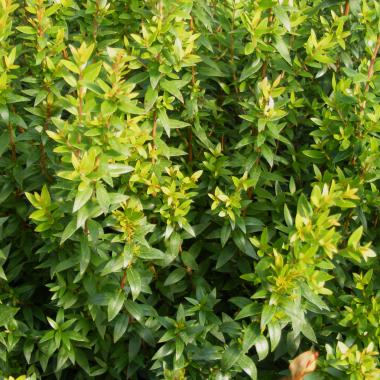


Myrtle
Myrtus communis

Myrtle is an evergreen shrub with glossy, attractive foliage.
It is native to the Mediterranean region, Middle East and North Africa.
It is believed to have been introduced to the UK from Spain in 1585 by Sir Walter Raleigh,
who brought orange trees at the same time.
With our cooler, damp climate it needs careful planting against a warm south facing wall in a dry sheltered position.
In the northern parts of the UK it is better grown in a large container which can be protected from the cold and wet in winter.
Historically Myrtle is a very notable plant.
It is mentioned several times in the bible and appears in the ancient mythology of both Greece and Rome.
Myrtle is closely associated with Aphrodite — the Greek goddess of love and beauty.
The Roman counterpart is Venus, as typified in the famous Venus de Milo statue.
Venus is described as emerging from the sea with a sprig of myrtle in her hand.
In the temple gardens dedicated to both goddesses, myrtle was always grown in abundance,
and Roman ladies wore myrtle wreaths in honour of Venus.
This has inspired bridal traditions using myrtle signifying the innocence of the bride.
Most especially the royal tradition starting with Queen Victoria.
In 1845 she was gifted a bouquet containing Myrtle by Prince Albert's grandmother.
A sprig from this was planted against the walls of Osborne House on the Isle of Wight — Queen Victoria's
family retreat — where it still grows and flourishes today.
Since that day a stem from that original myrtle bush has been included in all royal wedding bouquets
right up to the present day when Kate Middleton married Prince William in April of 2011.
Most of us think of Myrtle as an attractive shrub to grow as an ornamental,
but it is in fact a useful culinary herb, both the leaves, the flowers and subsequent berries can be used in cooking.
- Sardinia is the only country where myrtle is used commonly in cooking. It is used in the same way as bay leaves to give a spicy, bitter, citrus flavour and the leaves are then discarded before serving.
- It is also used in wood smoking to give a distinctive spicy flavour to the food.
- In Middle Eastern cuisine both the leaves and the berries are used especially with lamb and pork.
- The flavour is very similar to that of allspice and long shoots are wrapped around meat and poultry before roasting or grilling.
Herb teas made from the dried leaves and berries are used in the mediterranean region both
to lower blood glucose and also for bladder and urinary infections.
Myrtle berries in particular contain many compounds thought to be beneficial to human health.
Most especially myricetin — a flavonol — are anti-cancer, anti-inflammatory and anti-oxidant.
There are studies on-going that suggest that myricetin might be beneficial to diabetics and
also to alleviate the symptoms of Alzheimer's.